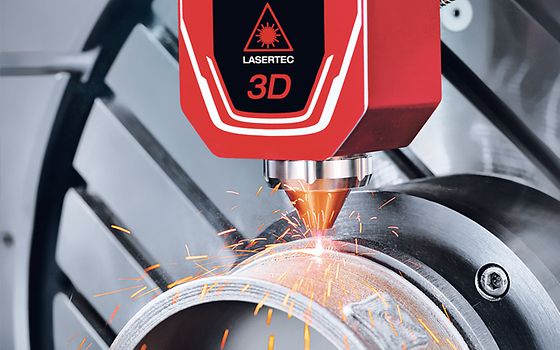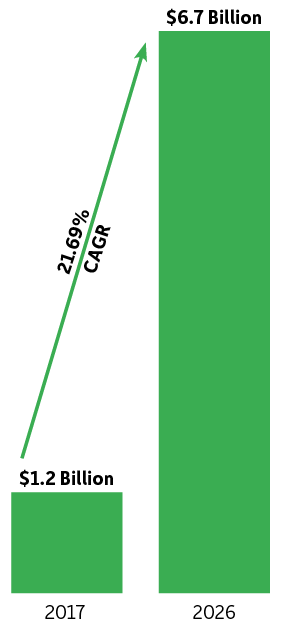Hybrid Manufacturing: A New Design Mindset

DMG Mori’s Lasertec 65 3D Hybrid features an integrated Siemens NX Hybrid CAD/CAM module for additive and subtractive programming. Image courtesy of DMG Mori.
Latest News
April 16, 2018
Are you ready to design for platforms combining metal additive manufacturing and traditional subtractive processes?
A new generation of hybrid manufacturing platforms is poised to challenge engineers by expanding their freedom to pursue design differently while facilitating more efficient and cost-effective production processes.
Hybrid solutions combine metal additive manufacturing (AM) with conventional subtractive capabilities such as CNC machining and milling in a single platform, allowing both processes to function on the same system and more importantly, be applied to the production of a single part. In a more traditional workflow, a component manufactured with AM technology may typically require a significant amount of post-processing work in CNC machines to achieve the accuracy and finishing that go along with its final dimensions. At the same time, a component that starts as a metal block and is milled to the desired shape is far more limiting in terms of accommodating complex geometries.
The advantages of supporting both processes in the same platform means metal AM parts can be produced from scratch in a single process while subtractive parts can be pushed to achieve organic shapes not possible with traditional manufacturing. There are cost efficiencies because there is a single machine, which takes up less space, and the learning curve is reduced because there is only one system to program. At the same time, the emerging paradigm challenges engineering teams to break out of the standard mindset, encouraging the design of new organic shapes that haven’t been possible with conventional practices.
Hybrid Manufacturing Growth
 The global hybrid additive manufacturing machine market is expected to expand at a compound annual growth rate of 21.69% from $1.2 billion in 2017 to $6.7 billion in 2026. Source: Transparency Market Research
The global hybrid additive manufacturing machine market is expected to expand at a compound annual growth rate of 21.69% from $1.2 billion in 2017 to $6.7 billion in 2026. Source: Transparency Market ResearchWhile the potential is high, it’s still early on, with a relatively small pool of hybrid manufacturing solutions available today, most at significantly high cost. However, the segment is growing, fueled by the introduction of a new stream of players and efforts by traditional AM printer vendors, which is driving a steady uptick in adoption rates. According to new data from Transparency Market Research, the global hybrid additive manufacturing machine market hit $1.2 billion in 2017 and is expected to reach $6.7 billion by 2026, expanding at a compound annual growth rate (CAGR) of 21.69%. Last year, hybrid manufacturing systems had the most traction in the aerospace sector given the industry’s focus on lightweighting and parts reduction through use of composite materials and complex geometries. The machines are expected to be used primarily for repair applications this year, but as hybrid manufacturing platforms come down in price, Transparency Market Research anticipates more mainstream deployment for production applications, expanding at a CAGR of about 24% between now and 2026.
Scott Sevick, vice president of manufacturing solutions at Stratasys, says he’s not surprised that there’s rising interest in hybrid manufacturing given the reality of how products are made today. “It’s a challenge to find anything that’s manufactured in a single set up,” he says. “Whether you think of today’s manufacturing processes as hybrid or not, they are. There is a multiple-step process for producing everything so it’s natural to examine how to become more efficient and take out steps in between. The trend you see in AM is to bring more and more steps into a common cell so you can eliminate those transition times that are a non-value add to manufacturing.”
Design for Hybrid Manufacturing
As part of its exploration into this emerging area, Stratasys has teamed up with Siemens to integrate its AM solutions with the automation giant’s Digital Factory platforms. In 2016, the companies showcased the Stratasys Robotic Composite 3D Demonstrator (see video above), which leveraged motion control, CNC automation technologies and PLM software to promote a hybrid approach to automated composite part production. While the 3D Demonstrator addressed the traditional limitations of composite lay-up and support materials with standard 3D printing, it serves as an architecture for other possible hybrid manufacturing combinations, including additive and subtractive processes, Sevcik says. Siemens and Stratasys have also been collaborating on enabling a seamless design-to-manufacturing workflow, enabling tighter integration between the NX CAD/CAM/CAE platform and Stratasys technology.
The design software advances are critical for engineers to capitalize on the advantages of a hybrid manufacturing platform, experts say. In that vein, CAE tools are evolving to allow for the simulation of a 3D printed part to ensure the process delivers the proper accuracy and strength attributes before it is physically produced, saving material costs and engineering design cycles. “You’re never quite sure which features will be made accurately and which won’t or which will have to be machined or not,” explains Brent Stucker, director of additive manufacturing for ANSYS. “There’s typically a lot of trial and error.”
With the help of simulation and 3D tools, engineers will also be able to stretch their design wings, creating and producing organic shapes that weren’t possible before. The combination of hybrid manufacturing solutions and new topology optimization and generative design software enables assemblies to be reimagined as single parts, eliminating the need to create interfaces between components and enabling the lightweighting and parts reduction strategies so critical for today’s products. “Traditionally a designer thinks about where there are interfaces that they might have to machine—now they can think about how to eliminate them and combine multiple components into one,” Stucker explains.
With a hybrid manufacturing approach, there is also less need to focus on placement of support structures—which is a real challenge for many design engineers integrating AM technologies into their workflow. Because hybrid manufacturing allows for different materials in a single process, engineers can more easily design parts that call for different material combinations. “This allows them to think more on a feature level, which allows for maximum design flexibility,” says Andreas Saar, vice president of manufacturing engineering solutions for Siemens PLM Software.
While progress is definitely being made on the hybrid manufacturing front, it will likely take time before the technology goes mainstream. “There’s so much work that needs to be done with software, with optimizing when to add materials and when to mill away, with supporting parts as they’re being built, and with heat distortion problems,” notes Terry Wohlers, president of Wohlers Associates, a consultancy specializing in AM. “It makes sense we can benefit from the best of both worlds, but there’s still a lot to hammer out.”
Subscribe to our FREE magazine, FREE email newsletters or both!
Latest News
Related Topics







